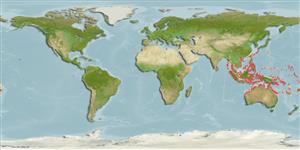>
Gobiiformes (Gobies) >
Gobiidae (Gobies) > Gobiinae
Etymology: Ctenogobiops: Greek, kteis, ktenos = comb + Latin, gobius = gudgeon + Greek, ops = appearance (Ref. 45335).
Environment: milieu / climate zone / depth range / distribution range
Écologie
marin récifal; profondeur 0 - 15 m (Ref. 48637). Tropical; 30°N - 24°S
Western Pacific: Ryukyu Islands to Queensland, Australia, east to Mariana Islands. Eastern Indian Ocean: Andaman Sea and northwest Australia (Ref. 9710); including China (Ref. 31517).
Taille / Poids / Âge
Maturity: Lm ? range ? - ? cm
Max length : 8.0 cm SL mâle / non sexé; (Ref. 48637)
Description synthétique
Clés d'identification | Morphologie | Morphométrie
Épines dorsales (Total) : 7; Rayons mous dorsaux (Total) : 11 - 12; Épines anales: 1; Rayons mous anaux: 11 - 12. Characterized by pale grey body color; side of body with four longitudinal rows of dark brown spots (midlateral row largest); presence of small ocellated yellow to orange spot between each pair of midlateral brown spot; head and body covered with scattered small yellow to brown spots; basal part of pectoral fin with intense white spot; longitudinal scale series 50-55; opening of gill extending to or slightly before vertical at posterior edge of preopercle; greatest depth of body 4.5-5.0 in SL; rounded caudal fin, about equal to head length (Ref. 90102).
Occurs on fine sand and silt bottoms of subtidal reef flats and lagoons to a depth over 20 m. Uses burrows of alpheid shrimps for refuge. Inhabits coastal sand slopes to about 15 meters depth (Ref. 48637).
Life cycle and mating behavior
Maturities | Reproduction | Spawnings | Egg(s) | Fecundities | Larves
Myers, R.F., 1991. Micronesian reef fishes. Second Ed. Coral Graphics, Barrigada, Guam. 298 p. (Ref. 1602)
Statut dans la liste rouge de l'IUCN (Ref. 130435)
Menace pour l'homme
Harmless
Utilisations par l'homme
Pêcheries: commercial; Aquarium: Commercial
Outils
Articles particuliers
Télécharger en XML
Sources Internet
Estimates based on models
Preferred temperature (Ref.
123201): 25.3 - 29.3, mean 28.7 °C (based on 2383 cells).
Phylogenetic diversity index (Ref.
82804): PD
50 = 0.5020 [Uniqueness, from 0.5 = low to 2.0 = high].
Bayesian length-weight: a=0.00708 (0.00333 - 0.01504), b=3.09 (2.92 - 3.26), in cm total length, based on LWR estimates for this (Sub)family-body shape (Ref.
93245).
Niveau trophique (Ref.
69278): 3.3 ±0.40 se; based on food items.
Résilience (Ref.
120179): Haut, temps minimum de doublement de population inférieur à 15 mois (Preliminary K or Fecundity.).
Fishing Vulnerability (Ref.
59153): Low vulnerability (10 of 100).
Nutrients (Ref.
124155): Calcium = 159 [71, 319] mg/100g; Iron = 0.798 [0.411, 1.557] mg/100g; Protein = 18 [16, 20] %; Omega3 = 0.0919 [, ] g/100g; Selenium = 20.8 [9.2, 48.3] μg/100g; VitaminA = 147 [39, 516] μg/100g; Zinc = 2.14 [1.36, 3.22] mg/100g (wet weight);
